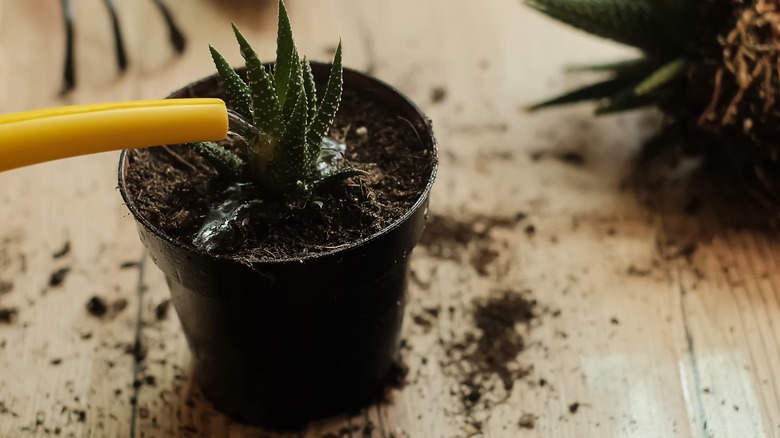Common Mistakes That Might Be Killing Your Zebra Succulent Plant
Whether you're new to growing houseplants or looking for one that won't end up in your plant graveyard, succulents, cacti, and other desert plants are usually a safe way to go. The zebra succulent is one very popular option in this category, with unique, radial leaves and fun textured ridges. The zebra succulent, also known as haworthia or zebra cactus, is a name that refers to a number of species in the Asphodelaceae family. In general, zebra succulents are relatively easy to care for, even seeming to thrive from neglect, so this eye-catching succulent is perfect for beginners to grow indoors. However, there are a few big mistakes to avoid when caring for a zebra succulent. Overwatering is the biggest danger for this desert-dwelling flora, but haworthias are also sensitive to direct sunlight and cold temperatures.
The truth of the matter is that all plants require some level of care, even low-maintenance options like zebra succulents. But by understanding and following some basic rules, you and your zebra plant can enjoy each other's cheery company for years to come. Here's why you should double-check yourself before making any of these devastating mistakes and tips for bringing your zebra plant back from the brink.
Avoid overwatering and weather extremes
You might feel like frequent watering shows your love and care, but overwatering is detrimental to zebra succulents. If overwatered, they can quickly develop root rot, which causes stunted growth, small leaves, and wrinkling or rotting. As a general rule of thumb, the soil should sit completely dry for a few days before you reach for that watering can. Is underwatering ever a concern with these plants? These are houseplants that you barely need to water because they are extremely efficient at soaking up and storing their own hydration. While it might sound extreme, they can easily go for weeks without a drink and be just fine, especially in winter. Having proper soil is the other key to avoiding root rot, so be sure to pot your zebra succulent in a good 50/50 mix of potting soil and drainage material, such as gravel, pumice, or poultry grit.
Of course, water isn't the only factor to be aware of. Although they're native to desert environments, zebra succulents can burn in direct sunlight. A place near a bright eastern or western window is more than sufficient for this plant. On the flip side, zebra succulents also aren't very tolerant of cold temperatures. Like most other succulents, frost damage presents a serious threat to zebra succulents. If your plant is kept outdoors, you'll need to bring it in when Fahrenheit temperatures drop into the 40s.
Reviving an unhealthy zebra succulent
Proper watering, sunlight, and temperature are key to a healthy, happy haworthia, but what should you do if you've made a mistake and your zebra succulent is looking sickly? Figuring out how to revive a dying succulent isn't easy, as they can rapidly succumb to root rot and other issues. If you suspect you've been overwatering, the first thing you'll need to do is help your plant dry out. Gently remove the zebra succulent from its pot, pinch off any decaying roots, and let the whole plant sit out in open air for a few days to a week. Remember, your plant has its own water supply, so it's more important that the roots are able to dry and heal for now.
If your plant has suffered from sunburn or frost, the damaged parts of the plant won't heal, but the rest of the plant may still survive! If you haven't already, remove it from the area and place it in a warm but shady spot, around 75 to 90 degrees Fahrenheit, ideally. A warm room indoors can also work. For sunburn, the plant will heal in time, just ensure that it receives the proper amount of water. For frost damage, you'll need to observe your plant closely for a few days and avoid overwatering. Once it's warmed up and dried out a bit, you can trim off any parts that still look discolored, mushy, or rotted, preserving as much healthy foliage as possible.


